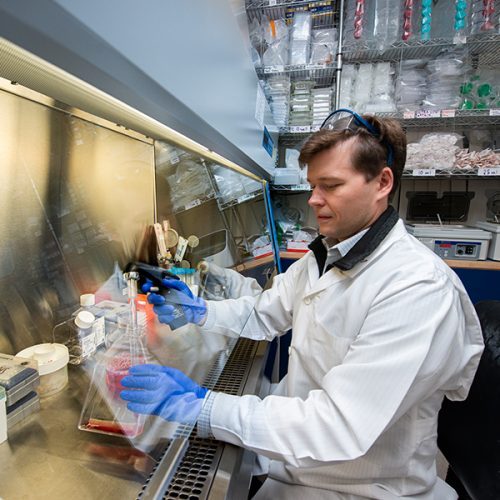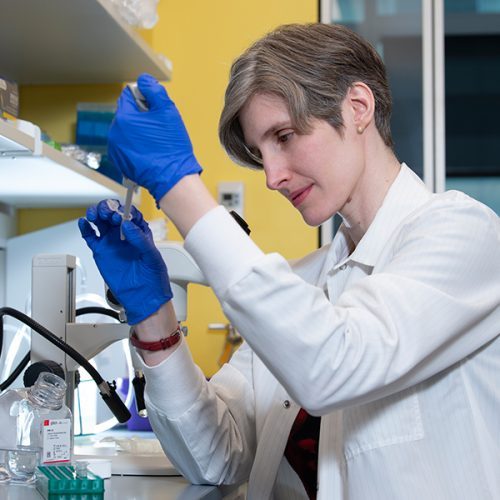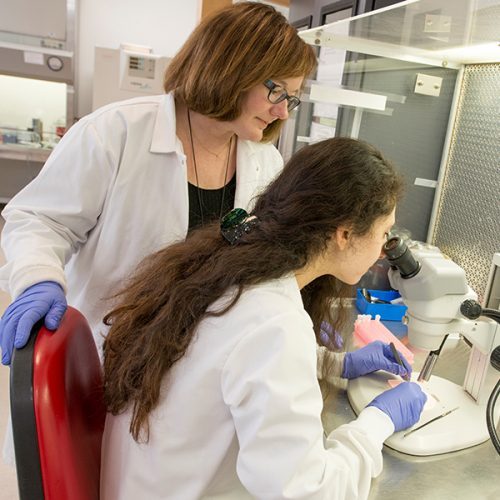Researchers at Massachusetts Eye and Ear are working toward eliminating blindness, with a particular focus on areas of greatest unmet medical need like age-related macular degeneration and glaucoma.
The year 2020 holds special significance for eye care providers and vision scientists—it’s a reminder that in our ideal world, everyone everywhere would have 20/20 vision.
In honor of this momentous year, Harvard Ophthalmology, together with Mass. Eye and Ear, has launched 2020 Vision—A World Without Blindness. This year-long initiative celebrates our steadfast commitment to eradicate blindness and ensure that every child will see in his or her lifetime. Throughout the year, Focus will be highlighting groundbreaking achievements and future goals in research, education and clinical care.
2020 Vision: Promising areas for future research
Our researchers have pioneered several important advancements in clinical care, such as proton beam irradiation for uveal melanoma, photodynamic therapy and anti-VEGF therapies for age-related macular degeneration, and the first and most commonly used artificial cornea transplant—the Boston Keratoprosthesis (KPro).
But there is still more work to be done. Our current and future research focuses on areas of greatest unmet medical need like retinal and macular degeneration, as well as conditions that damage the optic nerve like glaucoma.
Below, we take a close look at how our scientists plan to continue leading the way in some of the field’s most promising research areas, including artificial intelligence, big data, genetics and gene-based therapy, imaging, and other diagnostic technologies.
Age-related macular degeneration
Our researchers are currently working to advance the diagnosis, prevention, and treatment of age-related macular degeneration (AMD)—the leading cause of blindness in people over 50 years old. They are especially interested in identifying AMD subtypes and developing effective treatments for early and intermediate AMD and neuroprotection.
Learn more:
Diabetic eye disease
Diabetic eye disease is a group of eye problems, including diabetic retinopathy, diabetic macular edema, cataracts, and glaucoma, that can affect people with diabetes. Researchers are using advanced eye imaging tools to develop artificial intelligence algorithms that can help predict diabetic eye disease progression and treatment response.
Learn more:
Glaucoma
Glaucoma is a group of disorders that damage the eye’s optic nerve, resulting in vision loss or blindness. In most cases, the nerve damage is caused by increased pressure inside the eye. Prompt diagnosis and careful monitoring is essential because once vision is lost from glaucoma, it cannot be restored.
Our investigators aim to improve disease screening and risk prediction based on machine learning, eye imaging, and genetic risk factors.
Learn more:
- 3 ways artificial intelligence could fight eye disease
- Researchers to build cell atlas of the human eye
Ocular regeneration
Scientists are working to develop sight-saving and restoring therapies that will change the lives of patients with degenerative blinding eye diseases, such as such as AMD, glaucoma, cornea and dry eye diseases, and inherited retinal disorders.
Learn more:
Ocular genomics
Our researchers aim to use precision medicine broadly for inherited eye diseases. This emerging approach for disease treatment and prevention takes into account a person’s individual genes, environmental risk factors, and lifestyle. Researchers hope this will help improve genetic diagnoses for patients, leading to the use of gene-based therapies to preserve and/or restore vision.
Learn more:
- Discovery opens doors for AAV gene therapy research
- Researchers to build cell atlas of the human eye
- Luk Vandenberghe discusses gene therapy research for Usher syndrome
Cornea
The outer-most layer of the eye, the cornea, is susceptible to infections, swelling, injuries, and genetic conditions that can lead to vision loss. Our scientists are working to develop novel biomaterials that could be used for corneal replacement, regeneration, and the management of corneal injuries.
Learn more:
- Adhesive gel bonds to eye surface, could repair injuries without surgery
- Ultraviolet light exposure identified as factor linked to type of cornea dystrophy
- Breakthrough drug-eluting contact lens provides sustained drug delivery
- Tej Kohli Cornea Program at Mass. Eye and Ear
Infectious disease
Our investigators aim to develop promising new treatments to fight the leading causes of multidrug-resistant infections, including staph and other related bacteria. They are also working to develop new technologies for the rapid diagnosis of eye infections.
Learn more:
- Early detection of corneal infection before scarring or blindness occurs
- Researchers shed light on superbug evolution
Pediatric ophthalmology and strabismus
Children can develop many of the same eye problems that are seen in adults, but they often require specialized care. Our researchers aim to use gene therapy to treat and reverse vision loss in children and to apply precision medicine for the early diagnosis of pediatric eye diseases.
Strabismus can develop at any time during childhood, but most commonly occurs between birth and age five. Untreated, strabismus can impair depth perception and possibly lead to poor vision (amblyopia) if one eye becomes dominant. Our researchers hope to re-open brain plasticity to treat amblyopia in adults and to directly stimulate the visual brain to treat all forms of blindness.
Learn more:
Eye cancer
Our researchers are working to identify new biomarkers for earlier detection of a type of eye cancer called metastatic ocular melanoma. They are also working to develop supportive therapies and improve treatment outcomes for the condition.
Learn more:
Mobility enhancement and vision rehabilitation
Vision rehabilitation researchers are committed to helping those with visual impairments maximize their remaining sight and improve their quality of life and independence. They are developing more advanced head-mounted displays that use computer and image processing software to help patients navigate in their day-to-day lives.
Learn more:
- Smart App may help people with low vision search their surroundings
- Skip the yellow glasses for night driving, study says
“We hope you will be inspired by the magnitude of what we have already achieved. Each new discovery brings us one step closer to the revolutionary breakthroughs that will ultimately eliminate blindness worldwide,” Joan W. Miller, MD, Chief of Ophthalmology at Mass. Eye and Ear and Mass General Hospital, and Chair of Harvard Ophthalmology.
Learn more about ongoing ophthalmology research at Mass. Eye and Ear and Harvard Ophthalmology.





I have MD, treat at ME&E would be willing to be in any part of research
Thanks for leaving a comment, Diane. You can learn more about ongoing clinical research trials at Mass. Eye and Ear here: https://www.masseyeandear.org/research/clinical-trials
I was diagnosed and treated with proton beam radiation at Mass Eye & Ear. I have choroidal Melanoma in my right eye. It saved my life! The professionals there are the best you can get and I am so grateful for the care I received. I received the radiation therapy at the Francis Burr Proton Therapy Center. Here again the staff were great and guided me through the process with total professionalism and compassion. I also volunteered to be part of their research study. They are working hard to help people like me. Get your yearly eye exams!
Philip, thanks for your kind words about your experience at Mass. Eye and Ear. It means so much to everyone involved to hear such feedback.
I had a stroke in my optic nerve years ago. I still have partial vision in that eye. Looks like strings are in my eye. Willing to be in the research of your optic nerve research. Debra Malatesta. Connecticut
I have a sister who went blind at age 3 due to optic nerve damage. She is now 65. Has your research led to repairing the optic nerve?
Any information you can provide would be appreciated.
Thank you.